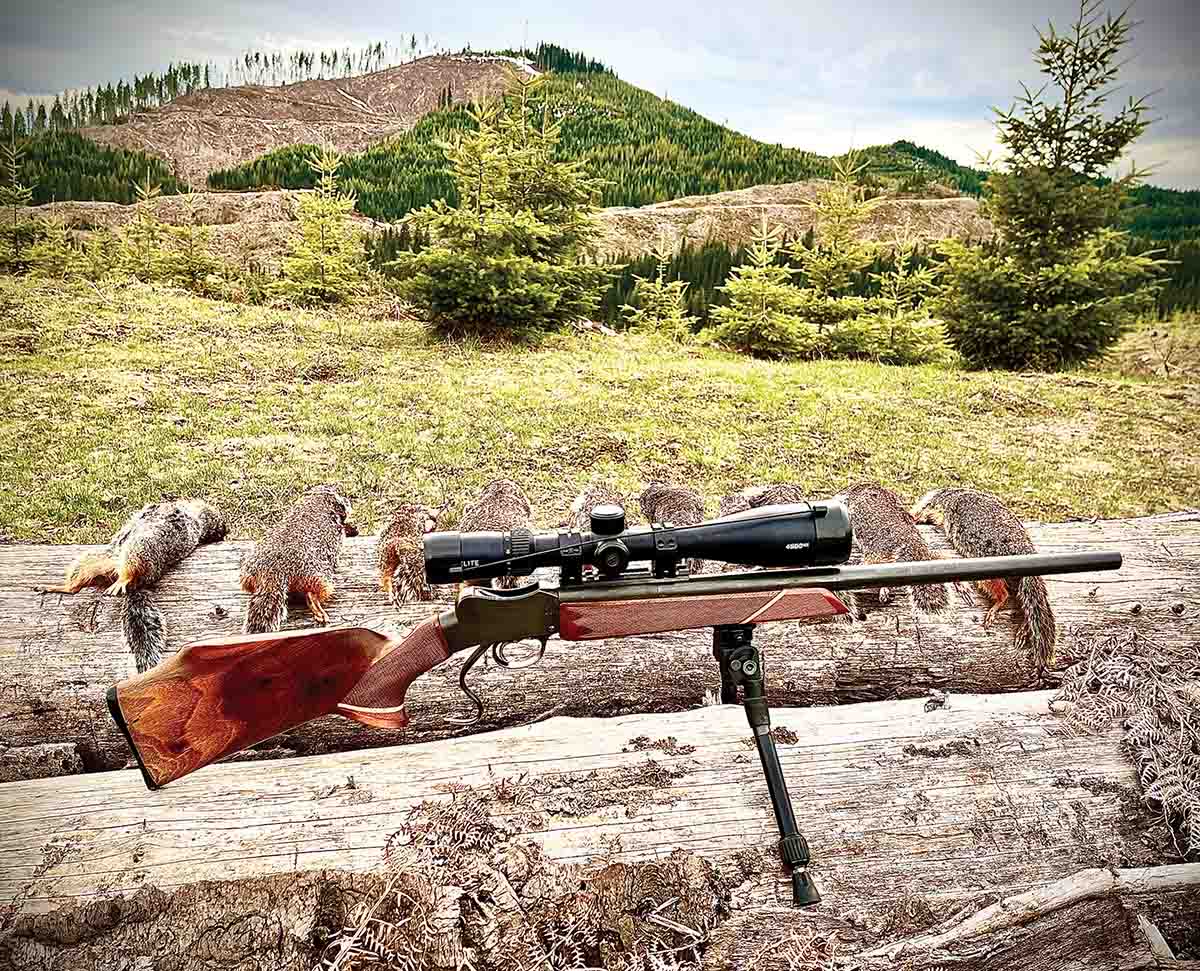
Patrick has owned his .22 K-Hornet rifle for only a single spring, but has put it to work on northern Idaho Columbia ground squirrels. The Martini single-shot action was rebarreled with a heavy 21½-inch barrel and shoots well.
While still an ardent .22 Hornet fan, more recently I have solved the Hornet accuracy conundrum by adopting the shouldered .22 K-Hornet. The basic problem with the .22 Hornet has always been its sloping shoulders and the fact the cartridge headspaces almost entirely off its prominent rim. This has generally made the round a touch fussy – aside from the small doses of fast-burning powder the round thrives on, which I’ll touch on momentarily. The K-Hornet has not only that rear rim, but a 35- to 40-degree shoulder to headspace on, which better aligns bullets and starting them straight down the bore. This automatically improves accuracy. The shouldered K-Hornet, in a quality rifle, is generally capable of more consistent accuracy than the .22 Hornet when fed carefully assembled handloads.
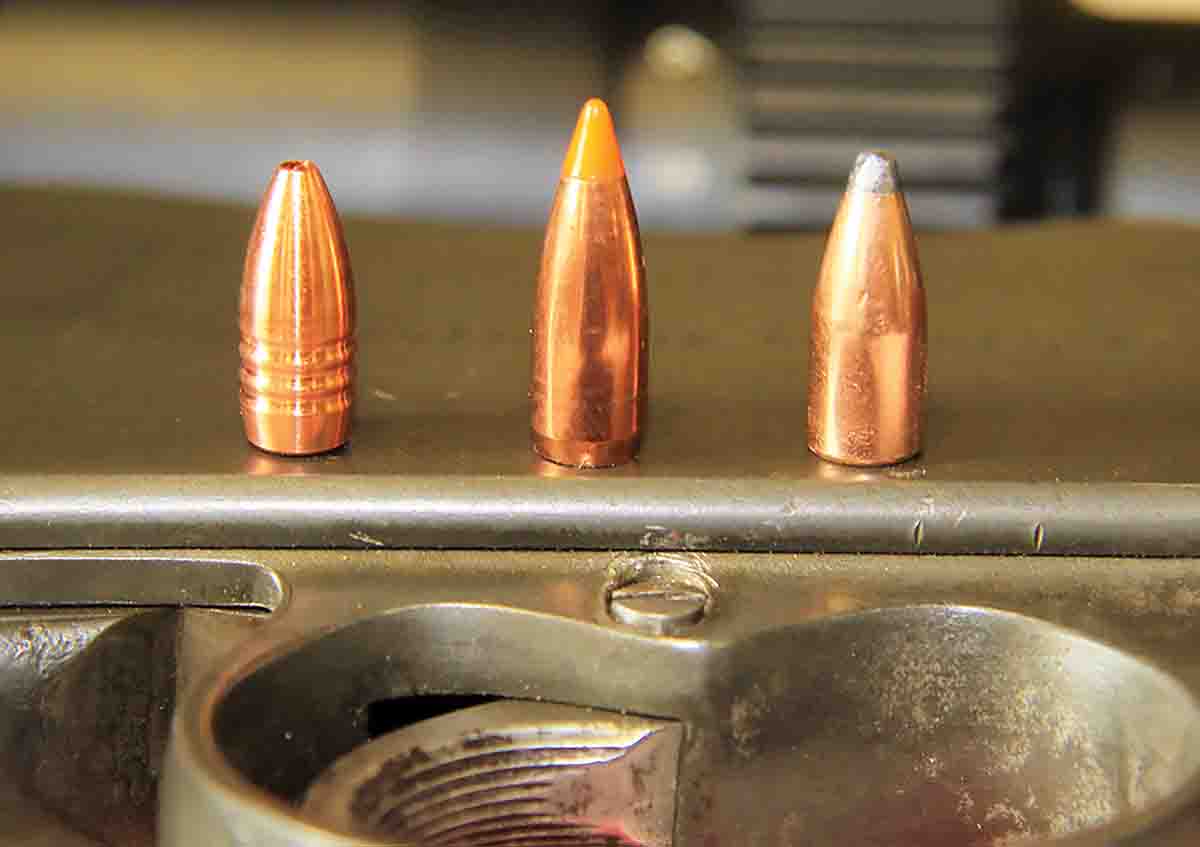
Bullets selected for 100-yard .22 K-Hornet rifle testing included (left to right): Hammer Bullets’ 35-grain Hammer Hunter, Nosler’s 40-grain Ballistic Tip Varmint and Hornady’s 45-grain Hornet softpoint.
The K-Hornet is the work of former Lyman employee Lysle Kilbourn – the K in K-Hornet – the cartridge was developed in 1940. It is basically an “improved” version of the .22 Hornet, including a .010- to .012-inch reduction in case taper, the aforementioned shoulder and a shortened neck. In comparison, new-production Remington cases fireformed in my K-Hornet rifle held 15.5 grains of water (spent primer in place, filled to the top of the neck) to the 14.3 grains of the same .22 Hornet cases prior to fireforming. The variations in specifications mentioned above are typical, as there are no Sporting Arms and Ammunition Manufacturers’ Institute (SAMMI) standards in place.
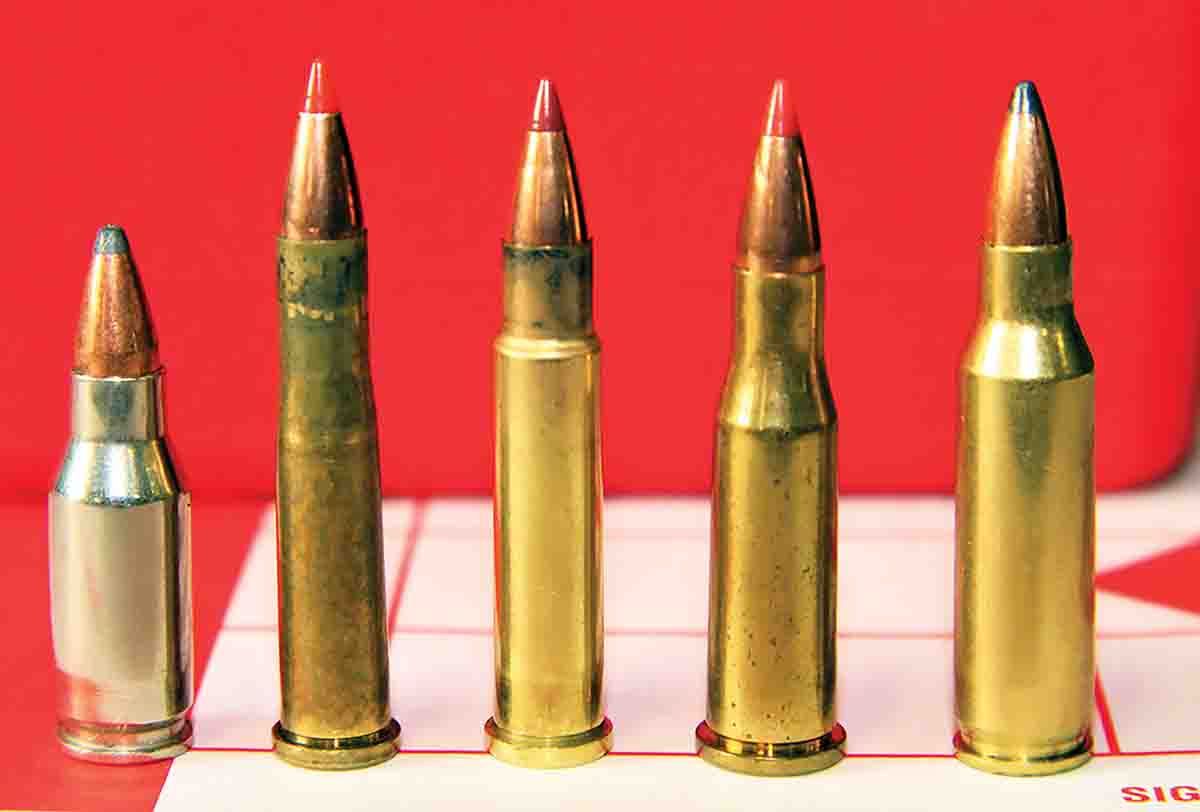
Shown for size comparison are: (1) Armscor .22 TCM, (2) ancient .22 Hornet, (3) .22 K-Hornet, (4) .218 Bee and (5) .221 Remington Fireball.
That 9 percent increase in powder capacity, and perhaps a more efficient case dynamic, give the K-Hornet a 100 to 150 feet per second (fps) velocity advantage over the .22 Hornet in most classic load data. That said, I have noticed even more marked velocity gains while using modern powders (Alliant Power Pro 300-MP and Hodgdon CFE BLK, in particular), as the improved case seems to hit some efficiency threshold with slower-burning propellants. The K-Hornet shoulder also generally results in improved case life and the need for less frequent trimming. Classic K-Hornet data indicates a maximum overall loaded length of 1.75 inches, compared to the 1.723 inches of the .22 Hornet. That said, my single-shot K-Hornet is not required to conform to the confines of a detachable magazine, so my overall lengths are often longer when using modern bullets, particularly polymer-tipped numbers.
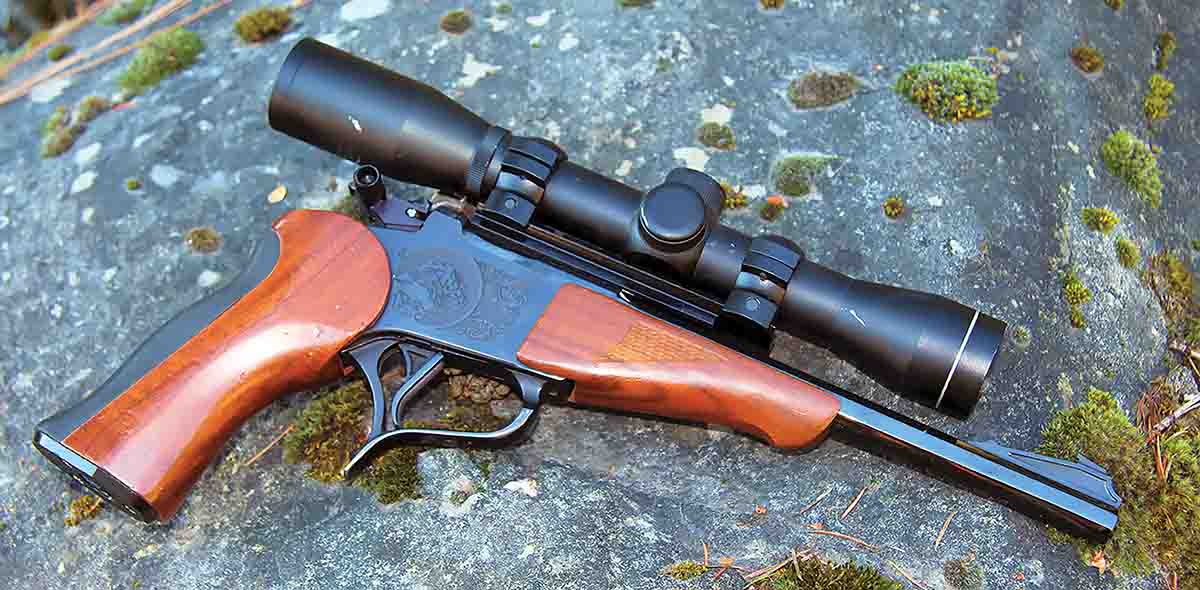
The Thompson/Center Contender pistol has garnered a cult-like following due to a single-shot, break-action system that allows fitting many different barrels/chamberings to a single T/C action. Barrels/scopes can also be interchanged without losing zero.
What the K-Hornet does share with the original in terms of accuracy potential is relatively minuscule powder charges. Accuracy with any small cartridge depends on tedious powder measurements. Deviations as small as 1⁄10 grain affect group size, as well as determine which load your rifle prefers. This also goes for case brands and even primers. My current K-Hornet varmint-shooting load – using current-production Remington cases – holds 15 grains of Hodgdon CFE BLK compressed by a 35-grain Hornady NTX bullet. Pour 15 grains of the same powder into a fireformed Hornady .22 Hornet case and it will spill over the top. Reducing the charge to create the same compression in the Hornady cases destroys accuracy with that load combination. Auditioning a number of different primer brands/types also typically relinquishes the best accuracy possible, including trying small pistol or small rifle magnum primers. Once an accurate load is discovered, changing even the smallest details can negatively affect accuracy.
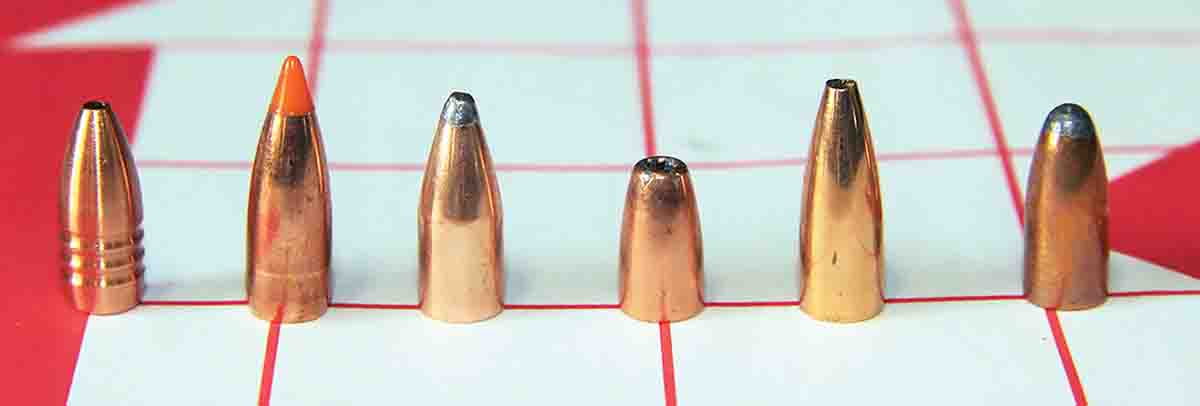
Bullets used to test the .22 K-Hornet included: (1) Hammer Bullets’ 35-grain Hammer Hunter, (2) Nosler’s 40-grain Ballistic Tip Varmint, (3) the Hornady 45-grain Hornet (rifle), (4) Speer’s 33-grain JHP, (5) Berger’s 40-grain Flat Base Varmint and (6) Sierra’s 45-grain Varminter Hornet (pistol).
The K-Hornet is strictly a handloader’s cartridge, as not even boutique brands offer loaded rounds, with only R.C.C. offering handloading brass (that I am aware of) but at about $4.50 a pop. Not to fret, cases are easily created by firing standard-issue .22 Hornet rounds through a K-Hornet chamber. Luckily, the fireforming process provides surprisingly good accuracy, which means you can enjoy productive varmint shooting while building your K-Hornet brass supply. Factory ammunition is easiest, of course, though factory .22 Hornet rounds are a bit pricey today – if you can find them. Fresh brass is recommended when handloading fireforming rounds, if again, you can find it. The other route is gun show brass or trading with a handloading hoarder for older brass, which can then be carefully annealed to avoid split necks/shoulders and ruined cases. Anneal-Rite’s system has worked well for me (CartridgeAnneal.com). During initial fireforming, I use affordable Speer 40-grain softpoints (fourteen cents each) and 10 grains of low-pressure IMR-4198. The fireforming process also fits cases to individual chambers, neck sizing then providing the most dependable accuracy.
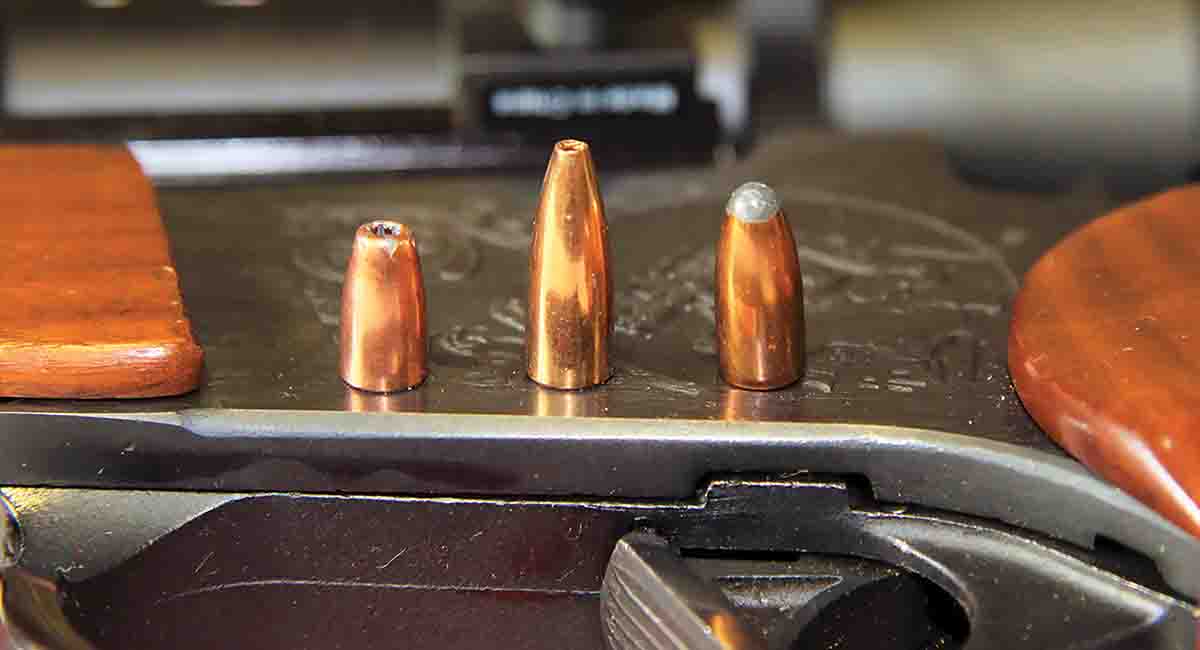
The .22 K-Hornet pistol was tested at 75 yards using Speer’s 33-grain JHP (left), Berger’s 40-grain Flat Base Varmint (center) and Sierra’s 45-grain Varminter Hornet (right).
A 35-degree shoulder and 1.13-inch rim-to-shoulder length are the dominant K-Hornet specs. Trim-to length is 1.39 inches. Shorter rim-to-shoulder dimensions will obviously require reducing maximum loads, so it is prudent to put a micrometer on fireformed cases.
I own a couple different K-Hornets – a single-shot rifle built around a Birmingham Small Arms Company (BSA) Martini single-shot action, as mentioned, and a Thomson/Center Contender single-shot pistol holding a classic 10-inch hexagonal barrel. The rifle is a trim 37-inches long, though it weighs a touch more than 9 pounds with its Bushnell Elite 4500 Multi-X 4-16x 50mm scope set in Weaver 4-hole rings. Its weight is made mostly by the 21½-inch, .795-inch diameter barrel, which includes a 1:14 twist rate. The stock was carved from gorgeous mesquite and includes back-slant rosewood forearm and grip caps separated by maple spacers, hand-checkering, a slim wrist, deep top thumb groove and Monte Carlo-style comb. Martinis, though stout actions, nonetheless include notoriously weak extractors, though this has not been an issue with the K-Hornet cartridge.
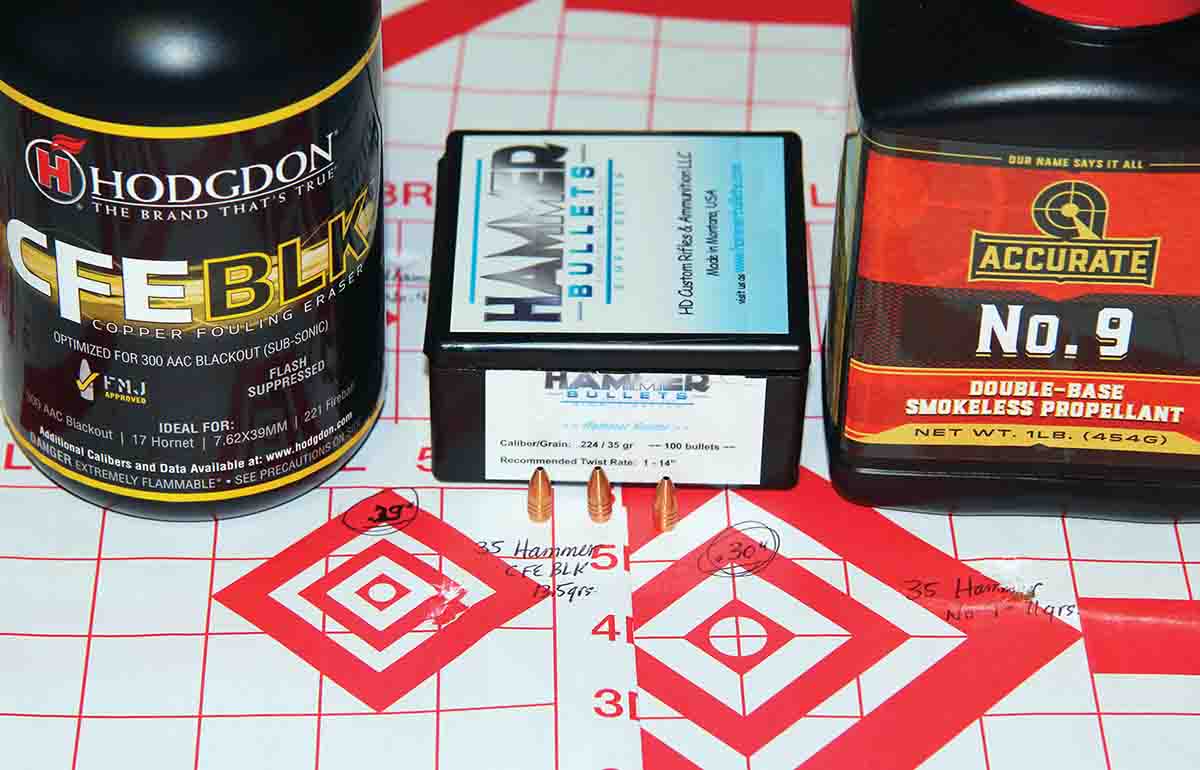
The very best loads of the entire K-Hornet test were produced by Hammer Bullet’s 35-grain Hammer Hunter – including a .29-inch group at 2,848 fps with 13.5 grains of Hodgdon CFE BLK and .30 inch at 3,158 fps with 11 grains of Accurate No. 9.
The break-action, single-shot Contender G1 pistol first appeared in 1967, the brainchild of Warren Center and was manufactured in partnership with K.W. Thompson Tool Company. My affection for the T/C Contender pistol stems from the ability to switch many barrels onto a single action, and the fact accuracy is typically good. I own barrels for the .22 Hornet, .221 Remington Fireball, .223 Remington, .256 Winchester Magnum, .30-30 Winchester and the K-Hornet used for testing here. Once a handgun scope is mounted to a barrel, it can be removed and returned in minutes, while retaining zero. As tested, the pistol had one of the original light hexagonal barrels measuring 10 inches long with a 1:14 twist and a like-new, blued finish. The Contender wore a cheap Target Sports 4x32mm pistol scope set in two-screw Weaver rings atop a T/C one-piece base.
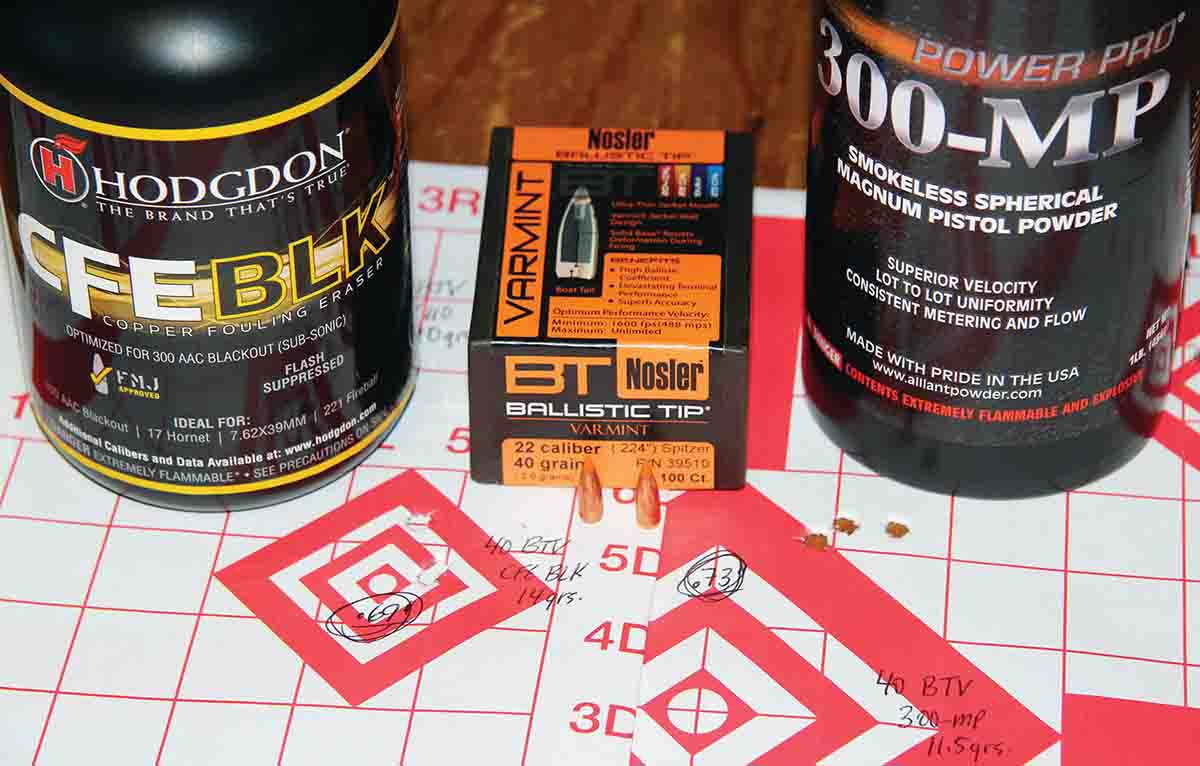
Nosler’s 40-grain Ballistic Tip Varmint produced a couple of sub-¾-inch groups – a .69-inch group at 2,797 fps with 14 grains of Hodgdon CFE BLK and a .73-inch group at 2,983 fps using 11.5 grains of Alliant Power Pro 300-MP.
Bullets for the two phases of this test, rifle and pistol, represented a mishmash of modern and classic options. For the rifle, two modern bullets and an old Hornet standby were tested. Hammer Bullets’ 35-grain Hammer Hunter is a milled monolithic-copper hollowpoint with a 1:14 minimum twist rate recommendation. It includes a G1 ballistic coefficient (BC) of around .166 and was designed to run hot, which might make it sort of a “controlled expansion” option at K-Hornet velocities, promising deadly results on something like mountain coyotes. Nosler’s 40-grain Ballistic Tip Varmint is the original poly-tipped varmint bullet, giving up a .221 G1 BC. Long experimentation with my .22 Hornet has shown this is the way to go with rounds in this class while seeking flattened trajectories at ranges beyond 250 yards. Hornady’s 45-grain Varmint Hornet is the sharpest of the Hornet-labeled softpoints and includes a G1 BC of .202.
Pistol bullets consisted of two classics and a modern option – the classics were chosen for maximum expansion at pistol velocities, the modern number an experiment to see how the 10-inch barrel would handle a longer profile. The Speer 33-grain Varmint JHP was Hornet inspired. It includes a flatnose hollowpoint to initiate rapid expansion, relinquishing a lackluster .080 G1 BC best suited to shots inside 100 yards. Berger’s 40-grain Flat Base Varmint is an old favorite, but one I’d yet to shoot through a pistol. The tangent ogive, hollowpoint includes a .151 G1 BC. Sierra’s 45-grain Varminter Hornet includes a more classic rounded softpoint profile for reliable expansion at a pistol pace and includes a .152-ish G1 BC at slower pistol velocities.
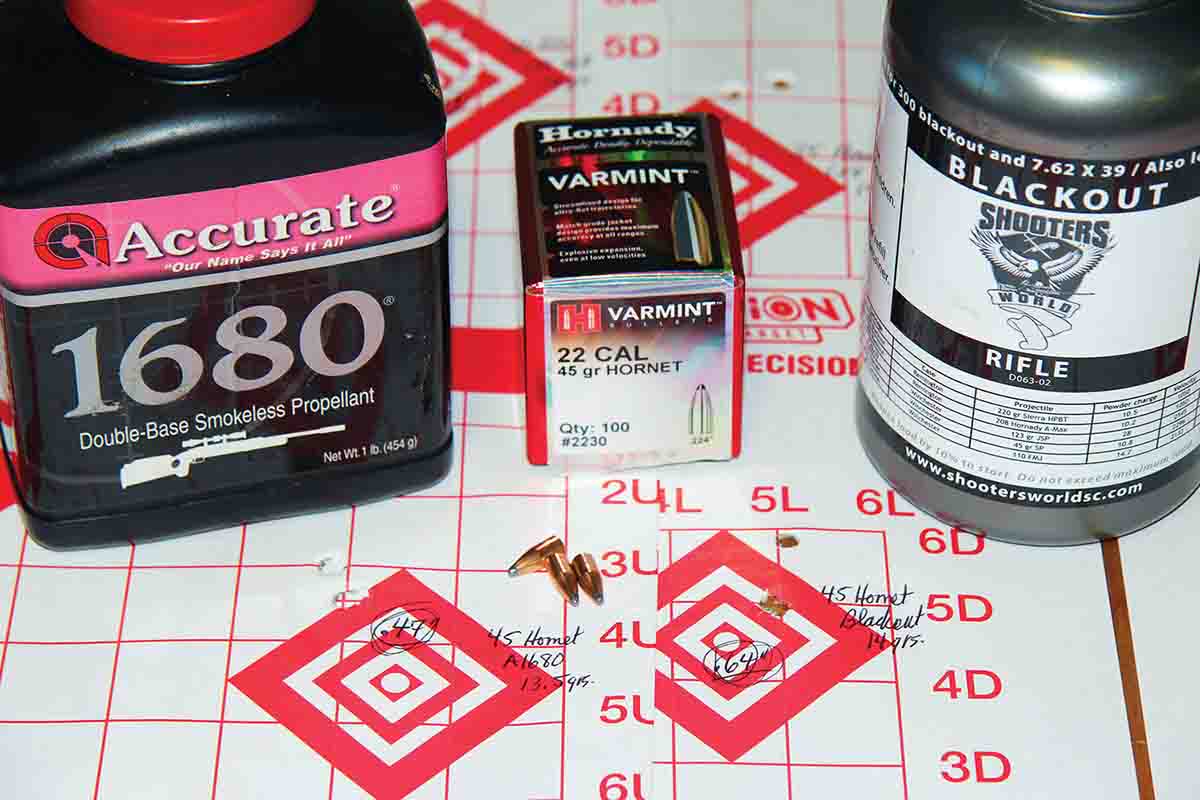
The best results with Sierra’s 45-grain Varminter Hornet softpoint included groups measuring .47 inch at 2,776 fps using 13.5 grains of Accurate 1680 and .64 inch at 2,834 fps using 14 grains of Shooters World Blackout.
Initial K-Hornet rifle testing revealed Alliant Power Pro 300, Hodgdon CFE BLK and Accurate 1680 were excellent choices, so they remained. I gave Vihtavuori N110 another chance, hoping for better accuracy (Sierra’s
Rifle & Handgun Reloading Data, Edition VI included it as the “most accurate load” with at least two different bullets). I also added Accurate No. 9 and TCM, plus Shooters World Blackout. From the pistol, Ramshot Enforcer, A-5744, TCM, A-4100, No. 9, No. 11FS, A-1680, and A-2015 were tried. Some of these powder choices were based on extensive work with Armscor’s similar .22 TCM, a cartridge that has a grain less capacity than the K-Hornet. All loads were assembled using Winchester WSR primers, Redding Series B dies and an Area 419 ZERO Reloading Press.
The loose K-Hornet cases I had on hand for this test were Hornady, so I was essentially starting from scratch, as I had only used new Remington cases to this point. Those cases held 15.5 grains of water, filled to the brim, the Hornady cases used here topped out at just 13 grains.
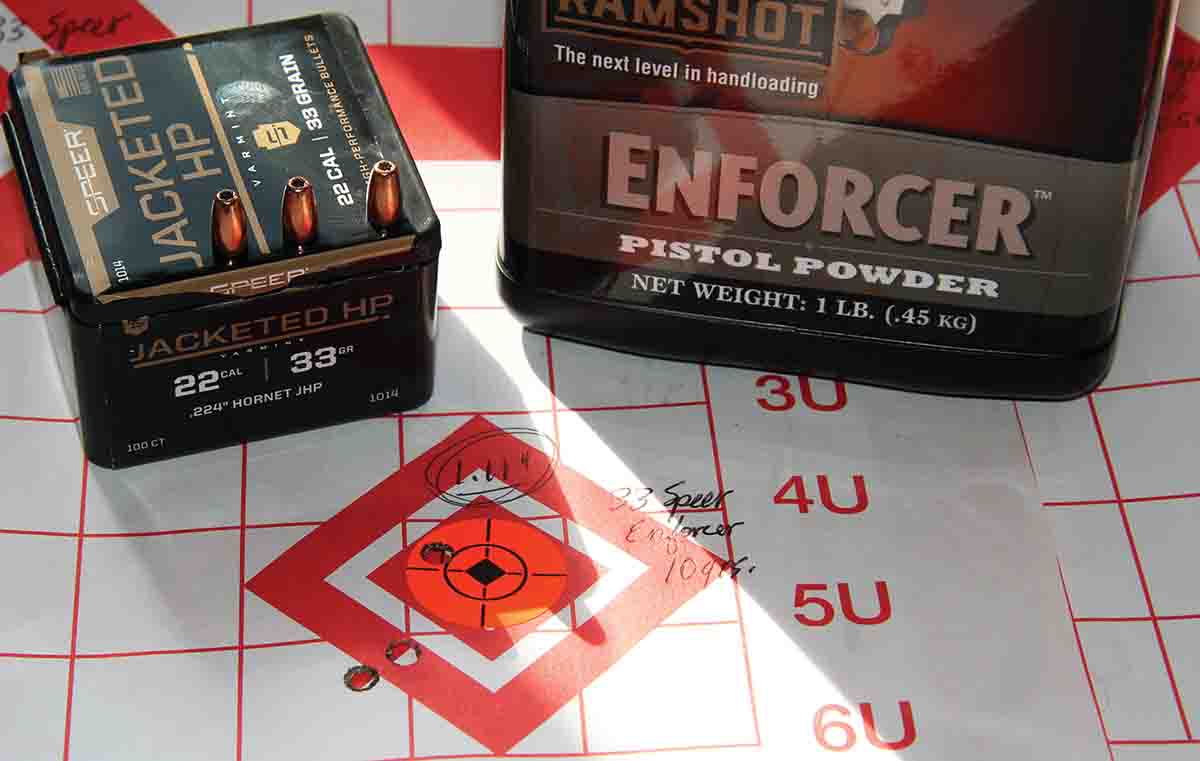
Shooting the K-Hornet pistol at 75 yards, Speer’s 33-grain JHP did best with 10 grains of Ramshot Enforcer. That group measured 1.11 inches at 2,489 fps from the 10-inch barrel.
The Hammer Hunter proved exceptionally accurate. Power Pro 300-MP printed .58- and .38-inch groups at 3,047 and 3,174 fps, using 11.5 and 12 grains of powder, respectively. No. 9 proved worthwhile, assembling .73-, .35- and .30-inch groups with 10, 10.5 and 11 grains of powder, in that order. Velocities ranged from 2,947 to 3,158 fps. CFE BLK provided the best overall group average and consistency across the board. Groups measured .59 inch with 14.5 grains of powder (3,019 fps), .52 inch with 14 grains (2,922 fps) and .29 inch with 13.5 grains of powder (2,848 fps).
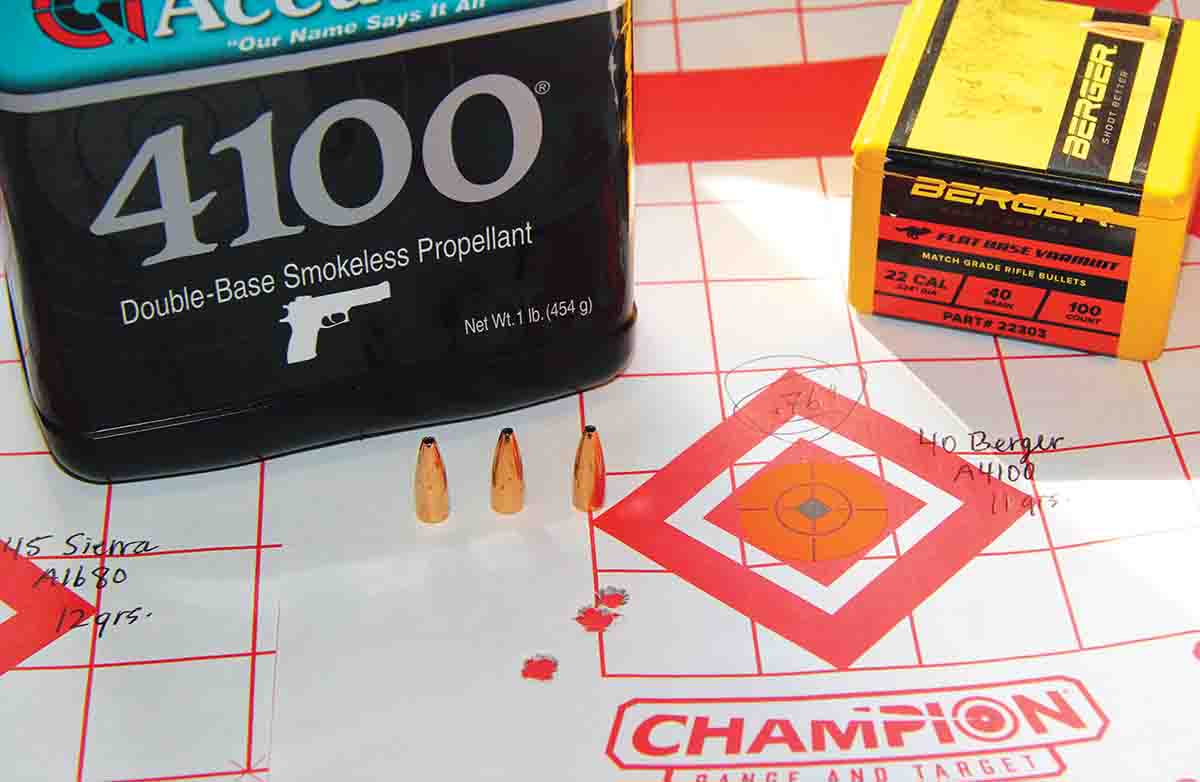
Eleven grains of Accurate 4100 and a 40-grain Berger Flat Base Varmint proved a good accuracy combination from the K-Hornet pistol, assembling a .76-inch group at 2,596 fps.
The Ballistic Tip Varmint was a surprise, just not meshing with my rifle. Vihtavuori N110 again failed to impress, its best group was just .91 inch at a pokey 2,597 fps. Power Pro 300-MP did slightly better with a .73-inch group at 2,983 fps, with the best group measuring .69 inch, shot with 14 grains of CFE BLK at 2,797 fps. Everything else ranged from an inch to 1.34 inches.
Accurate TCM proved disappointing with the 45-grain Hornady, groups ranged from 1.14 to 1.38 inches, though velocity was phenomenal – starting at 2,661 fps with 9.5 grains and finishing at 2,888 fps using 10.5 grains of powder. This velocity alone warrants further experimentation. Shooters World Blackout provided a .64-inch group at 2,834 fps using a maximum load of 14 grains of powder. These were experiments, but all cases extracted easily and no pressure signs were observed. Accurate 1680 was the easy winner, its best group being .47 inch at 2,776 fps, with 13 grains breaking an inch at 2,693 fps.
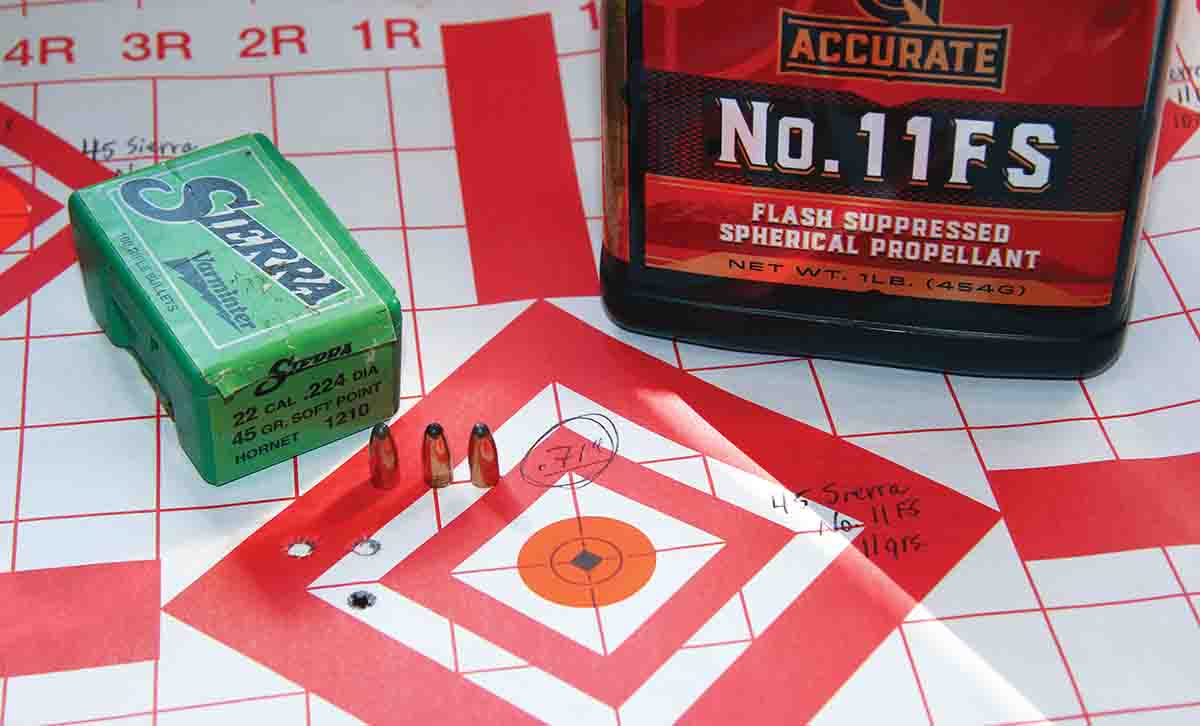
The best group from the pistol loads included Sierra’s 45-grain Varminter Hornet softpoint seated over 11 grains of Accurate No. 11FS. That group measured .71 inch with a velocity of 2,394 fps.
I had no prior load developments to guide me, so all loads were shots in the dark. The 4x pistol scope also left a bit to be desired at 75 yards. The Speer really should have been shot at 50 yards, though a couple loads managed “minute of ground squirrel,” or at less than 1½ inches. Ramshot Enforcer did that with a maximum 10 grains of powder, assembling a 1.11-inch group at 2,489 fps from the 10-inch barrel. Ten grains of Accurate 5744 also met that mark, printing 1.40 inches at a snail’s pace 1,991 fps. Accurate 5744 would prove ideal for eatable small game such as cottontail rabbits, promising minimum meat damage. Accurate TCM almost made the cutoff, assembling a 1.53-inch group at a speedy 2,836 fps.
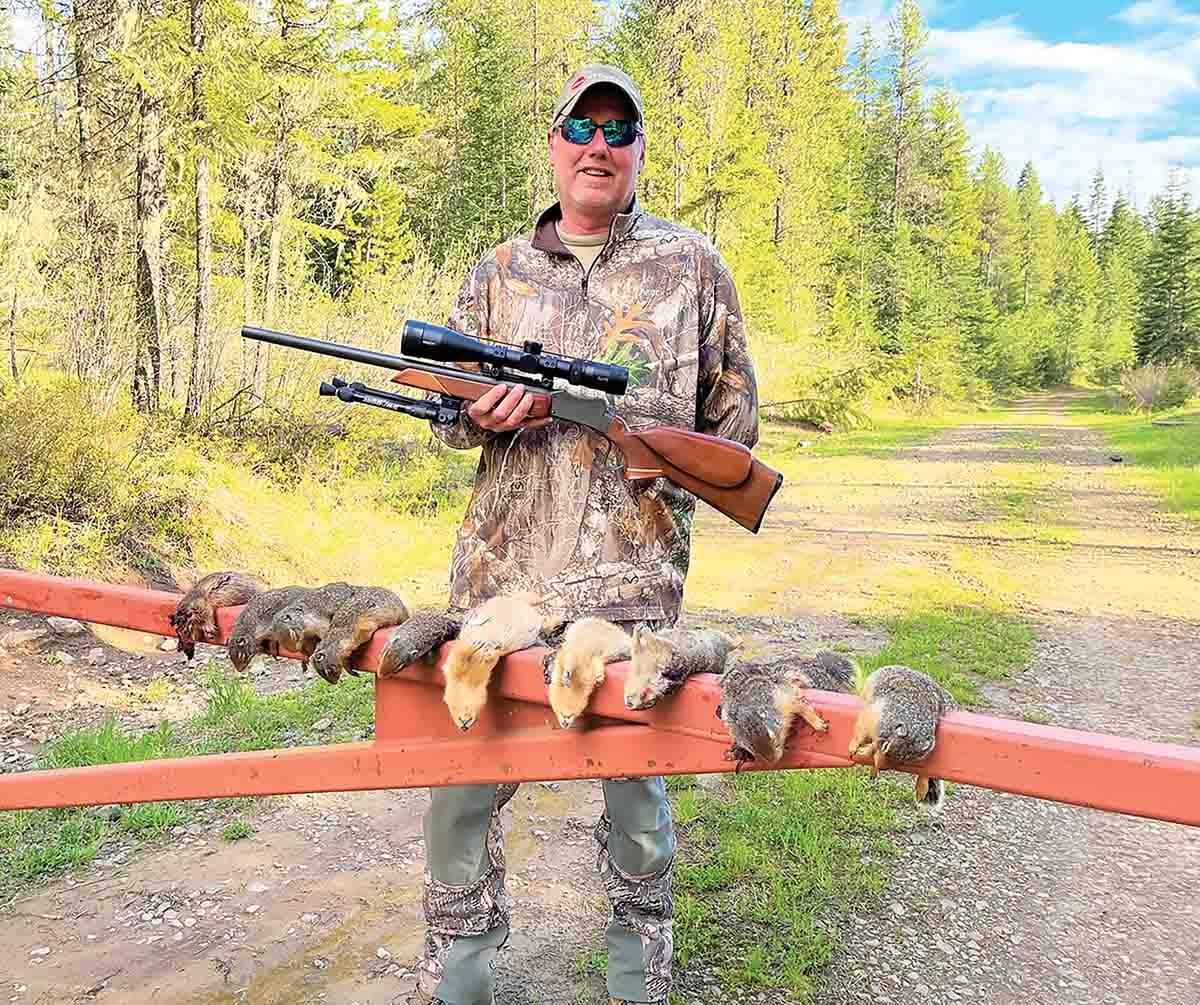
Patrick owns more varmint rifles than he likes to admit, but his recently-acquired .22 K-Hornet single shot has become one of his favorites. It has proven exceptionally mild-mannered and quite accurate.
The Berger produced the second-best group of the test and overall lower group averages. No. 9 produced a 1.26-inch group at a respectable 2,519 fps, while Power Pro 300-MP gave a 1.22-inch group at 2,600 fps. Accurate 4100 turned in the best group of .76 inch at 2,596 fps – making it the easy winner and likely the go-to load for this pistol.
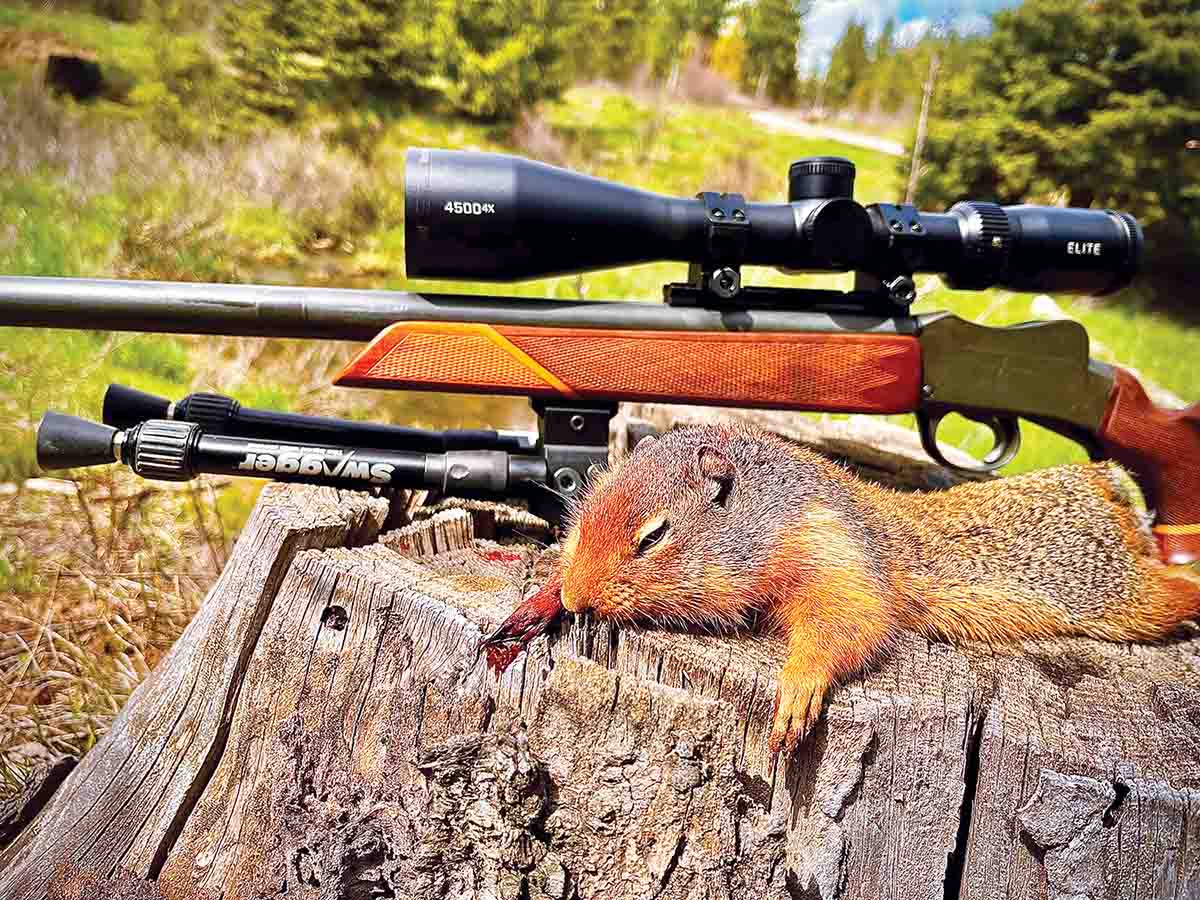
Patrick used his rebarreled Martini single-shot rifle to take this Columbia ground squirrel at about 150 yards, shooting a lead-free Hornady 35-grain NTX (not included in this test).
The Sierra Hornet 45-grainer produced the best group of this test, but also some of the worst. A-1680 produced groups between 1.62 and 2.65 inches, and velocities from 2,254 to 2,302 fps. Accurate 2015 did only slightly better, and at super-slow velocities from 1,716 to 1,881 fps – another short-range eatable small-game option. Accurate No. 11FS started badly, but the maximum load of 11 grains produced the smallest group of the test, .71 inch at 2,394 fps.
Load testing often serves more to show what doesn’t work and I certainly learned that in this series. Vihtavuori N110, A-5744 and A-2015 – in particular – are permanently out. Accurate 4100, No. 11FS, Enforcer, and perhaps Blackout, will get more attention in subsequent tests. TCM’s velocity is intriguing, but accuracy was not there. Overall, the safe bets are No. 9, Power Pro 300-MP, CFE BLK and A-1680.
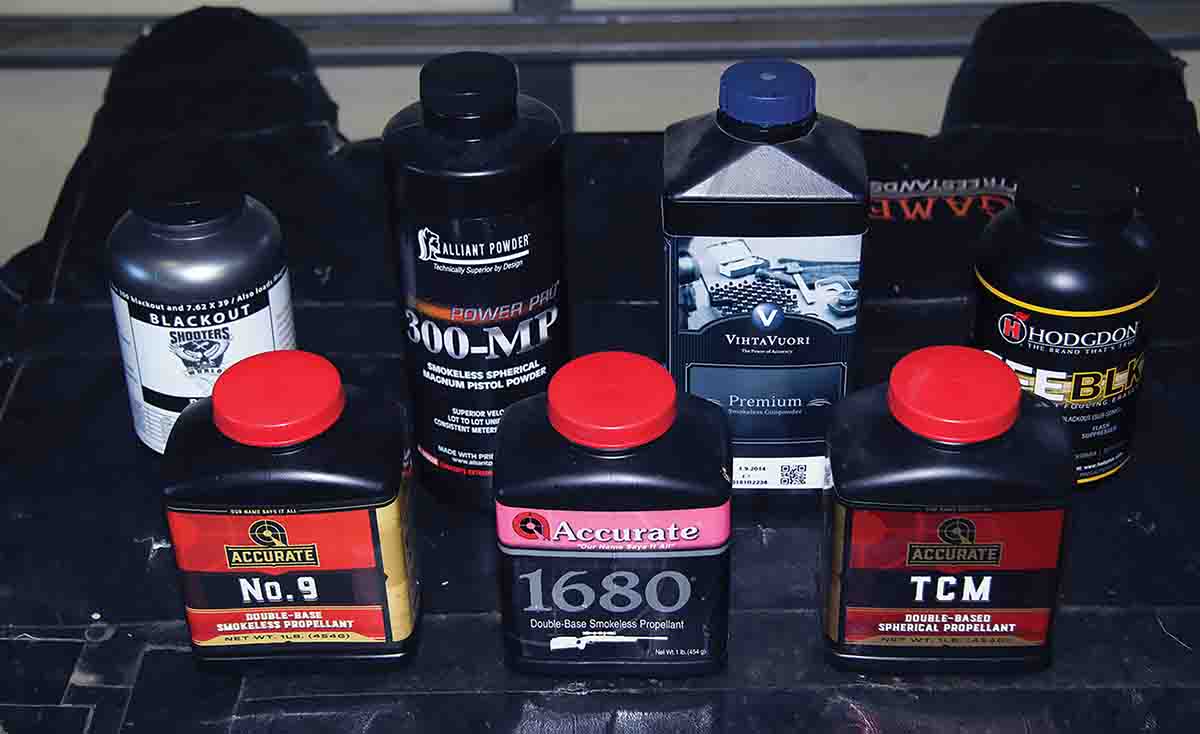
Powders selected for testing .22 K-Hornet rifle loads included: Shooters World Blackout, Alliant Power Pro 300-MP, Vihtavuori N110, Hodgdon CFE BLK, Accurate No. 9, 1680 and TCM.
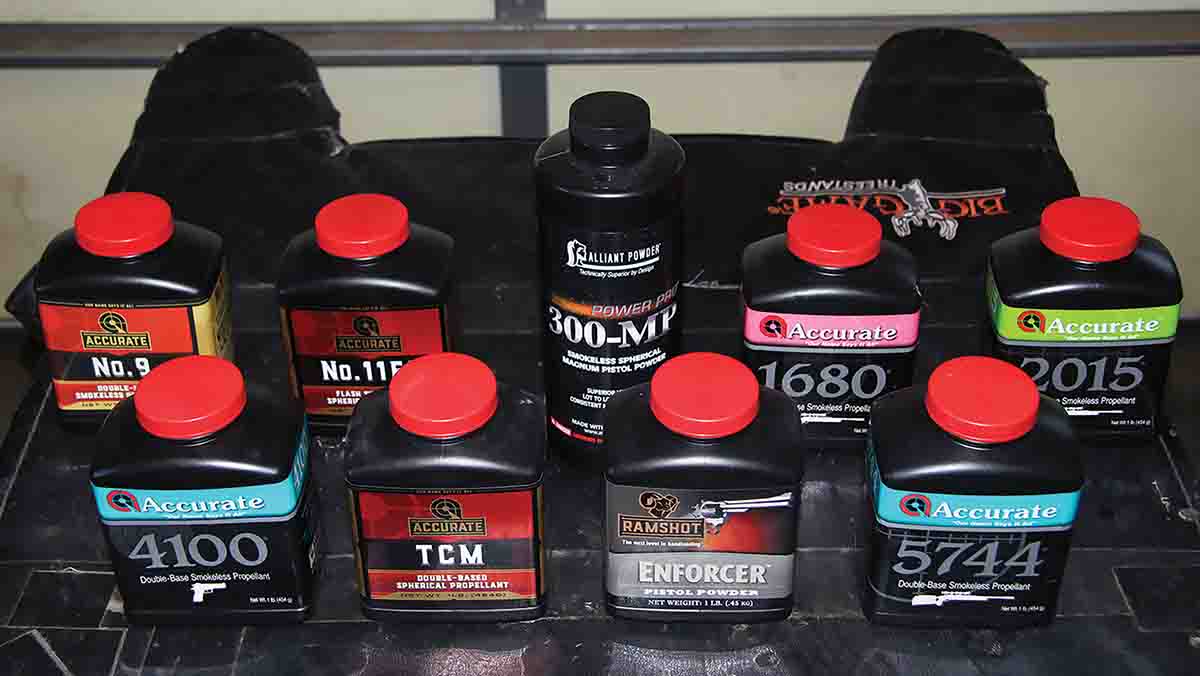
Nine powders were used for .22 K-Hornet pistol loads, including Accurate No. 9 and No. 11FS, Alliant Powder Pro 300-MP, Accurate 1680, 2015, 4100, TCM, Ramshot Enforcer and Accurate 5744.
















.jpg)


